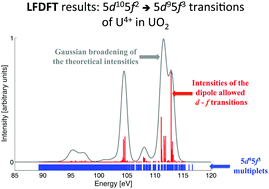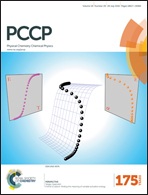Core electron excitations in U4+: modelling of the nd105f2 → nd95f3 transitions with n = 3, 4 and 5 by ligand field tools and density functional theory†
Abstract
Ligand field density functional theory (LFDFT) calculations have been used to model the uranium M4,5, N4,5 and O4,5-edge X-ray absorption near edge structure (XANES) in UO2, characterized by the promotion of one electron from the core and the semi-core 3d, 4d and 5d orbitals of U4+ to the valence 5f. The model describes the procedure to resolve non-empirically the multiplet energy levels originating from the two-open-shell system with d and f electrons and to calculate the oscillator strengths corresponding to the dipole allowed d10f2 → d9f3 transitions appropriate to represent the d electron excitation process. In the first step, the energy and UO2 unit-cell volume corresponding to the minimum structures are determined using the Hubbard model (DFT+U) approach. The model of the optical properties due to the uranium nd105f2 → nd95f3 transitions, with n = 3, 4 and 5, has been tackled by means of electronic structure calculations based on the ligand field concept emulating the Slater–Condon integrals, the spin–orbit coupling constants and the parameters of the ligand field potential needed by the ligand field Hamiltonian from Density Functional Theory. A deep-rooted theoretical procedure using the LFDFT approach has been established for actinide-bearing systems that can be valuable to compute targeted results, such as spectroscopic details at the electronic scale. As a case study, uranium dioxide has been considered because it is a nuclear fuel material, and both atomic and electronic structure calculations are indispensable for a deeper understanding of irradiation driven microstructural changes occurring in this material.


 Please wait while we load your content...
Please wait while we load your content...